Hippeastrum vittatum



Stemless / Acaulescent
A plant that has no stems, when the flower stalks and leaf blades are produced from ground level.
Clumping
A plant that when multiplies forms a clump.This bulbous perennial has upright to lax green long lanced-shaped leaves and forms a clump. The large red or crimson trumpet-shaped flowers appear in a cluster high above the foliage on a stout stem during spring.
Hippeastrum vittatum is naturally found in Peru, South America growing in tropical and subtropical regions. It prefers a well drained organic rich moist fertile light loamy soil with a pH range from 6.5 to 7.5 and grows in an open sunny wind protected position and is frost and drought tender.
Hippeastrum is grown for its colourful flowers and clumping habit. It is planted along borders in small or cottage gardens or mass planted for bedding displays. It is also grown in pots and tubs and used indoors use when in flower. The flowers are used in floral arrangements and when planting out space the plants 150 mm to 200 mm (7 ¾ in) apart and protect exposed bulbs from frost. Once established it has a medium water requirement, (Scale: 2-drops from 3) and responds to mulching with an occasional deep watering during dry periods. ID 61
Note:
Care should be taken as plant parts may cause a stomach upset if ingested.
UK hardiness zone H2
Climate zones H1, H2, 15 - 17, 21 - 24
USDA Zone 10-11
Hippeastrum (hi-pee-AS-trum) vittatum (vi-tah-tum)
'Hippeastrum': from Greek hippeus + astron - a knight's star; 'vittatum': striped or branded.
Cultivar
'Carnival'
This plant produces striking flowers that have bright red petals that are suffused with white and a prominent central white stripe.
Amaryllidaceae (AM-ar-ee-LEE-da-AY-see-ee)
These plants have a perennial bulb with basal leaves and flowers that occur in umbles.
Distribution
This family of plants range from wet to dry environments.
Diagnostic Features
These plants have a bulb from which strap like leaves arise.
The flowers are symmetrical, bisexual and occur in umbels on unbranched peduncles that have large bracts at the base. The perianth segments are unfused, large and showy with some species having a corona arising as a result of the linked filaments.
There are six stamens and the ovary is inferior that consists of three carpels with 1 to 3 chambers each consisting of numerous ovules. They have an unbranched style that has three short lobes.
The fruit is either a capsule or berry and the numerous seeds contain an endosperm.
Note:
There are many showy and common species in this family.
This plant tolerates between USDA zones 10a to 11a and grows to 0.3 m (1 ft)
Fahrenheit 30ºF to 45º F
These temperatures represent the lowest average
Celsius -1.6ºC to 7.2º C
Attention
All photographs and data are covered by copyright. Apart from any fair dealing for the purpose of private study, research, reference or review, as permitted under the Copyright Act, no part may be reproduced by any means with out written permission. All inquiries should be addressed to plantfile.com attention Peter Kirkland.

Simple
The leaf that is not divided.
Lanceolate
Broadest at the centre, three or more times long as broad (Lance-shape).
Opposite
Leaves that are arranged opposite to each other.
Entire
A leaf margin with no irregularities (smooth).
Funnelform
A flower where the petals form a funnel shape.
Umbel
When the pedicels arise from the same point on the peduncle.| Jan | Feb | Mar | Apr | May | Jun |
| Jul | Aug | Sep | Oct | Nov | Dec |
There are 2 to 6 large funnelform flowers arranged in an umbel that is held above the foliage on a thick scape and appear during spring. The flower colour varies from red, pink to white and crimson.

Capsule
A dried dehiscent fruit, with an enclosing membrane normally containing may seeds."| Jan | Feb | Mar | Apr | May | Jun |
| Jul | Aug | Sep | Oct | Nov | Dec |
Very large fleshy capsule grows to 110 mm (4 in) long and contains a flat winged seed. The seeds are viable but the plant is commonly reproduced vegetatively to maintain true to type.
Note:
Care should be taken as the bulbs are toxic if ingested.
Hippeastrum is grown for its colourful flowers and is planted in garden borders or as a specimen. It is also planted in containers for indoor use when flowering and used in courtyards. The flowers are used in floral arrangements and when planting out space the plants 150 mm to 200 mm (7 ¾ in) apart. If plant parts are ingested they may cause a stomach upset.
Note:
Other pests or diseases that may attack this plant include Bulb scale, Caterpillars and Cutworms.
Sow fresh seed during summer and seedlings take 2 to 3 years to flower. Divide bulblets during winter.
Plant out during late autumn at a depth of 30 mm to 50 mm (2 in). The plants dislike being disturbed and should be re-potted every 4 years.
Propagation by Seed (General)
In order for a seed to germinate it must fulfil three conditions.
1. The embryo must be alive (a viable seed).
2. The seed must have no dormancy-inducing physiological, physical or chemical barrier to germination; also the seed must be nondormant.
3. The seed must have the appropriate environmental requirements, water, temperature and oxygen.
The interaction between these requirements and dormancy is complex which may lead to different environmental requirements that avoid the dormancy of a seed.
Sowing Seeds in Containers
There are two general methods for germinating seeds.
1. Sowing seeds in a flat or germinating bed, through which seedlings are pricked-out then, transplanted into another flat with wider spacing or directly to an individual pot.
2. Sowing seeds by placing them in to flats with the appropriate spacing or into individual pots.
This method is normally carried out with medium to large seeds such as woody plants and plants that are difficult to transplant.
Seedling production normally occurs in a greenhouse / glasshouse, cold frames and on hot beds.
Method of Seed Sowing
Fine seed is sown in pots or flats that are no deeper than 70 to 80 mm. using a sterilised well-drained media (soil). Fill the container to 20 mm from the top and sprinkle sieved peat to 3 mm depth.
Press the media down level then firm with a piece of timber and then thoroughly moisten.
Mix the fine seed with washed sand and then sow thinly on the surface. These may be lightly covered with sand.
Larger seeds may be covered with media or a hole is dibbled and the seed is placed in the media.
Watering Methods
For watering you may either mist the containers from above or place the container in tepid water and allow the water to raise through the pot to the surface of the media, then drain away and do not fill to the top of the container.
Place a piece of glass over the pot and store in a protected warm environment (glasshouse).
Seeds germinate best in darkness so shade the containers if in direct sunlight.
After the seedlings have sprouted remove the glass and ease the seedlings into direct light.
When the seedlings are large enough prick them out then transplant into larger containers and place them in a shade-house to harden off.
Many seeds have different methods of seed preparation for germination such as nicking or cutting the seed coat to allow water penetration, also placing seeds in hot water and allowing it to cool off.
This is particularly important as it is softening the seed coat.
Bulbs, Tubers and Corms (General)
This is an underground organ with a short fleshy stem and a flower primordium that is enclosed by fleshy scales. The structure of this monocotyledon is designed for food storage and reproduction.
Tunicate Bulbs; daffodils, tulip, onion
These bulbs have a dry outer layer that protects the fleshy concentric inner scales as in an onion forming a solid appearance.
Nontunicate Bulbs lilies
These bulbs have no protective dry outer layer and are easily damaged. The scales are separate and are attached to the basil plate so care should be taken to keep them moist, as drying is detrimental to their health. Roots appear from the base and in some cases from the stem, normally growing during mid summer to autumn.
Offsets or Bulblets
This type of propagation is used on many bulbs and are normally removed when the bulbs are lifted then planted as separate plants. Some plants require a few years to produce offsets and they can remain on the plant undisturbed for many seasons.
Tulip produces offsets which should be lifted when the foliage dies off and daffodil forms offsets (split) over several years. These offsets may be stored or planted up directly.
Lilies increase slowly but the bulb in some species may be split and the scales produce bulblets as with other lily species bulblets are produced at the base.
Stem Cuttings
Lily species may be grown from stem cuttings where bulblets form at the base of the stem or leaf-bud cuttings with a single leaf and an old stem heal, the bulblets will form in the axil of the leaf.
Basal Cuttage
This method includes 'scooping' and 'scoring' on larger bulbs 170mm diameter. Scooping is carried out with a curved blade removing the basal plate of the bulb. Adventitious bulblets develop on the exposed scales.
The scoring method involves three cuts through the basal plate of the bulb, which produces bulblets in the axils of the scales.
In both of these methods the bulbs are planted out for one to two seasons where the mother bulb disintegrates and the bulbils multiply then grow.
Leaf Cuttings
This method is used for blood lily, hyacinth and other species. Well-developed leaves are cut from the base, then cut into sections and planted in a rooting medium 30mm deep. In a few weeks bulbils will develop at the base of the leaf. These are then potted up and grown on.
Bulb Cuttings
Narcissus, Hippeastrum, Cooperia and many other species may be propagated in this method.
The mature bulb is cut into eight to ten sections each containing a part of the basal plate. These are planted in a rooting medium vertically as to just show the tip and maintained in a warm environment. Bulbils will form at the basal plate with in a few weeks. After developing the bulbils are potted up.
Corm
The corm is a swollen base that is covered in a protective tunic, which prevents drying out. It is composed of scale like leaves that have nodes and internodes where axillary buds develop. There are two types of roots, fleshy contractile from the new corms and fibrous from the base of the mother corm.
After the foliage dies off the corm is lifted then allowed to stand after which old corms, new corms and cormels are separated.
The cormels are stored during winter and planted during spring after soaking in water for 2 to 3 days. These may be planted into containers or in a prepared bed and allowed to grow on for one season.
The corm may also be divided by cutting it into sections, which develop into new corms.
Tubers
This is a swollen underground stem that acts as a food storage organ with nodes and small buds as in the potato. Tubers may be propagated by either cutting the tuber in to pieces that contain buds (eyes) with sufficient stored food for growth or planted as a complete tuber.
Tuberous Roots and Stems.
These tuber roots differ in that there are no nodes or internodes and the buds are only produced at the crown with fibrous roots at the opposite end. The tuberous stems have a vertical orientation and arise from the first nodes as in Cyclamen species.
One or more bud is produced at the top of the crown and may be propagated by dividing the tuber so that it contains a shoot bud. Each section should be dried for a few days and stored in sawdust or vermiculite to avoid shrivelling.
In a warm humid environment the tubers will shoot.
Rhizomes
A rhizome is a stem that grows horizontally either below or on the surface of the soil with the shoots growing vertically as in bamboo and many grasses. The stems are composed of nodes and inter nodes giving it a segmented appearance.
Propagation is normally carried out by division during spring and autumn, by cutting the rhizome into sections each with at least one node. Placed on a moist bed or slightly buried and kept them warm which will produce roots, shoots from the nodes.
Pseudobulbs
This is a large fleshy section of the stem that may have one or several nodes. They are produced on orchids and may vary depending on the species. They are propagated from offsets, which develop at the nodes or by division of the rhizome containing pseudobulbs during the dormant period.
PEST
NAME
Caterpillars (General)
Various species
Description of the Pest
There are many types of caterpillars from moths or butterflies, cutworms, bag moths, case moths, leaf rollers leaf skeletonises. The larvae generally eat leaves, seeds, flowers or buds by chewing out pieces. The size of the piece will depend on the size of the caterpillar and generally they are voracious eaters. The method of eating varies such as the leaf skeletoniser which leaves a network of veins or whole leaves are consumed.
The larvae have mainly 4 or 5 pairs of prolegs except Loopers which have 2 -3 pairs of prolegs. The number of prolegs can help in identifying the insect.
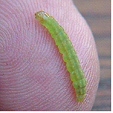 Small and Large Types
Small and Large Types 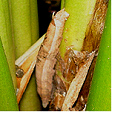
Casuarina Moth (Pernattia exposita) is gregarious, brown with a large head and tufts of hairs that line the slender body. It grows to 25 mm long and forms a tightly woven cocoon on the side of branchlets. The large female adult moth has a stocky body and generally slow moving, the male is smaller.
The larvae cause extensive damage to A. littoralis, A. stricta, C. cunninghamiana, C. glauca, and C. equisetifolia.
The hairy larva feed on the 'leaves" phyllodes, and stems, this can lead to ringbarking and death of branches.
Monitoring
Place sheets on the ground and disturb (shake) the tree for the larva drop to the ground on silken threads.
Spruce Budworm (Choristoneura fumiferana) is a reddish brown with a yellow stripe on its side and chews on the opening buds and the needles of the host. The adult moth is dull grey with brown bands and spots on the wings, appearing in early summer. The larva is very destructive in northern hemisphere coniferous forests.
Banksia Moth (Danima banksiae) is a caterpillar up to 60 mm long and is brown with black and white markings on its sides and when disturbed it arch backwards and reveal an extruded red underside, close to its head. The grey adult moth has an orange coloured body with a wing span that is up to 80mm across with black and white markings.
Banana moth (Opogona sacchari) is in the order Lepidoptera. This nocturnal moth as a wing span up to 25 mm wide and is bright yellowish brown with a dark brown spot on the wings. It has a life cycle that lasts approximately 3 months with the eggs hatching in 12 days and the whitish larva with a reddish brown head is up to, 26 mm long, and lives for 50 days at 15° C. In warmer climates life cycle is quicker with up to eight generations per season. The female moth uses a ovipositor to lay up to 500 eggs in groups of five amongst the crevices of the plant. The voracious larvae tunnel into the plant, avoiding light. In bananas it infests developing fruit and in ornamental plants it prefers the fleshy stems, particularly in cacti, begonias, African violets and is also a serious pest of Pritchardia and Chamaedorea species. Symptoms include tunnelling activity, which may be difficult to see then dead areas appear on the stems. As the caterpillars destroyed xylem tubes leaves begin to wilt and the plant may collapse and die. In European countries it is a glasshouse pest that is controlled chemically.
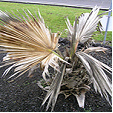 Pritchardi species
Pritchardi species 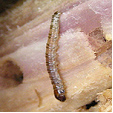 Banana moth larvae
Banana moth larvae
European Pine Shoot Moth (Rhyacionia buoliana) lays eggs on Pinus species during late spring on the new buds and the emerging caterpillars in late summer feed on the shoots causing them to fold and become deformed, eventually dieing. A major problem in the pine forests of the northern hemisphere
Large Grass Yellow Butterfly (Eurema hecabe) is a small attractive yellow butterfly. with a wing span of 40 mm that lays its eggs on the feathery leaves on Acacia species such as A. baileyana, (Cootamundra wattle), A. spectabilis (glory wattle). Other plant foods include Cassia spp, Caesalpinia spp, Senna spp. Albizia julibrissin (silk tree) A. paraserianthes (Albizia) sp Aeschynomene sp (Budda pea), Indigofera australis (Australian indigo's), Sesbania cannabina (yellow pea-bush), Senna surattensis (Glossy shower), Leucaena leucocephala (wild tamarind).
The small lava are up to 15mm long, green with white lateral bands and feed on the leaves at night in small groups, hiding under the leaves during the day. Large infestations may strip trees and require control. The larva of this insect does not feed on grasses. The adults are important pollinators of many Australian native plants. Various sub species of this insect are found through out Asia.
Gypsy Moth (Porthetria dispar) lava is a hairy grey caterpillar that is marked with blue and red dots along its back and can grow to 75mm long. It is capable of defoliating large trees and is a major problem for several species. A major problem in the northern hemisphere.
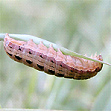 Lawn Armyworm
Lawn Armyworm
Lawn Armyworm (Spodoptera mauritia) is a plump, smooth caterpillar that is darkish brown to black with multiple stripes and pattens along its body. It can grow to 50mm long and tapers from the head. They are gregarious and move around in groups, like an army. If disturbed the larva drop to the ground and curl up, "faking death" The larva pupate in the soil. They are a pest of grasses and monocotyledon crops mainly.
This insect is also found throughout Asia.
Monitoring
Drench a known area with old fashion soap 2L / 1000 cm 2. Note the numbers of larvae emerging.
Oblique-banded Leaf Roller (Choristoneura roseceana) lava feeds on the leaves and forms a nest by drawing the leaf margins together using silk threads. The adult moth is up to 25mm across the wingspan and is reddish brown with three darker brown bands across the wings. This is a problem in the apple growing areas of North America. It feeds on Maples, hawthorns, crab apples, Blackberry (bramble) and raspberries.
Red Humped Caterpillar (Schizura concinna) is a lava has a red head and humps with yellow and black strips on the body. It grows from eggs that were laid on the underside of leaves by the adult greyish brown moth that has a wing span up to 30mm across.
Tailed Emperor Caterpillar (Polyura pyrrhus spp. sempronius) adult is a large butterfly with a wing span up to 110 mm with four long tapering tails and the rear of the wings. The fleshy caterpillar with four obvious backward facing horns on a shield shape head. It is dark green with yellowish bands and transversal stripes over its back and grows up to 80 mm in length.
It is commonly found solitary or in small groups. Found over much on mainland Australia. The adults are attracted to overripe fruits they become drunk on this and so are easy to capture. The larvae feed on many plants including, Acacia baileyana (Cootamundra Wattle, A. spectabilis (Glory wattle), Delonix regia (Poinciana), Cinnamomum camphora (Camphor laurel) Robinia pseudoacacia (Black or false locust) Lagerstroemia indica (Crepe Myrtle), Argyrodendron actinophyllum (Black booyong), Celtis spp (Hackberry), Brachychiton spp (Kurrajongs) Gleditsia triacanthos (Honey locust).
Verbena Moth (Crambodes talidiformis) lays its eggs on the outside of the plant and the small green caterpillar that attacks seed pods by entering and eating the contents. It half emerges while pupating appearing as a small brown bump circled by a black ring. Native to North America
White Tussock Moth (Hemerocampa leucostigma) produces lava that is up to 50mm long. It has a red head with a yellow body that is marked in black and has four tufts of hair. The caterpillars pupate on the branches and the eggs laid by the adult moth overwinter on the trunk and are covered in a white waxy material. They are found on Aesculus species. A pest in North America of Oaks.
Life Cycle
This insect has a Holometabolous life cycle, i.e. it has a larval and a pupal stage.
Distribution of the Pest
Many species are found throughout the world from tropical to temperate regions and most of the adults are capable of by flying
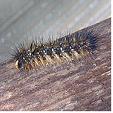 Many hairy caterpillars can be irritating
Many hairy caterpillars can be irritating 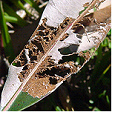 Leaf Skeletonised
Leaf Skeletonised
Period of Activity
Most active during the warmer months from spring to autumn.
.
Damage Caused
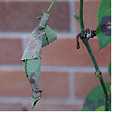 Leaf Rollers
Leaf Rollers
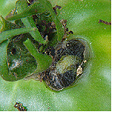 Caterpillar Inside a Tomato
Caterpillar Inside a Tomato
Susceptible Plants
A wide range of native and exotic plants are attacked and can be a major problem in commercial crops or turf grasses. Plants with soft-textured foliage (eg vegetables, some indoor plants) are preferred, but trees and shrubs are commonly attacked.
Malvaceae Abutilon spp, Hibiscus spp and other members of the family are attacked by the castor oil looper, Croton caterpillar (Achaea janata) which feed on leaves. The tip borer Cotton tipworm (Crocidosema plebejana), Rough bollworm (Earias huegeliana) which feeds on young stems, flowers and seeds. A leaf miner (Phyllonorycter spp)
Acer saccharinum and Fagus species are attacked in North America by the Maple Leafcutter (Paraclemensia acerifoliella) that forms a small cocoon in leaves that it skeletonises.
In Australia Case moths and Painted apple moths (Teia anartoides)
Ailanthus altissima is attacked by the Cynthia Moth (Samia cynthia) light green lava, which eats leaves and the Ailanthus Webworm (Atteva aurea) which are olive-brown caterpillars that form web nests in the leaves.
Antirrhinum species are attacked by the Leaf Tier (Udea rubigalis) lava. This caterpillar eats pieces out of leaves and binds them together forming a nest. It is more commonly found in glasshouse culture.
Berberis species may become infested with the Barberry Worm (Omphalocera dentosa). This small caterpillar is black with white spots, up to 14mm long and feeds on young shoots and leaves. It also binds the shoots with a silken thread to form a nest.
Betula species are attacked by the Leaf Skeletonizer (Bucculatrix canadensiella). The small adult moth has brown wings with a whitish underside and its yellow green, 7mm long lava skeletonise the undersides of the leaf turning it brown.
Brachychiton, Senna and feathery-leaved Acacia species are attacked by the Tailed Emperor Caterpillar, particularly in dryer periods.
Catalpa species are attacked Catalpa Sphinx (Ceratomia catalpae). This large yellow and black Caterpillar grows to 76mm long and attacks the leaves. Large infestations can completely stripped a tree and control is carried out by spraying.
Calendula and Canna species are attacked by the Woollybear Caterpillar (Diacrisia virginica) which has yellow and black lines down its body is up to 50mm long and eats the leaves or flower buds. In Canna species the chewed holes tend to be in a straight line across the leaf.
Celtis species are attacked by the Spiny Caterpillar (Nymphalis antiopa) which is reddish, up to 50mm long and feeds on the leaves at the top of branched in groups.
Cheiranthus species are attacked by the Diamond-backed Moth (Plutella maculipennis) lava, which is a small green caterpillar to 14mm long that feeds on the underside of leaves and may form a shot hole appearance. It forms a small cocoon to pupate in and in cooler climates it may be found in glasshouses.
Cotinus, Fraxinus, Betula, Cornus, Crataegus, Aesculus, Tilia, Acer, Quercus and Populus species are susceptible to attacked by the Oblique-banded Leaf Roller (Archips rosaceana)
Iris and Antirrhinum species are attacked by Verbena Moth.
Picea, Abies, Tsuga and Pinus species are attacked by Budworm commonly found in the northern hemisphere.
Populus and Carya species are attacked by the Red Humped Caterpillar which chews the leaves.
Quercus species are attacked by several caterpillars including Saddleback Caterpillar (Sibine stimulea) and Datana Caterpillar (Datana ministra) that feed on the leaves.
Samanea saman is attacked by several caterpillars (Ascalapha odorata, Polydesma indomita and Melipotis indomita). These caterpillars defoliate the tree but cause no long term problems.
Spiraea, Fraxinus, Betula, Cornus, Crateagus, Acer, Quercus and Populus species are attacked by the Oblique-banded Leaf Roller.
Ulmus, Salix, Crateagus, Tilia, Quercus and Populus species, Pseudotsuga menziesii are attacked by the Gypsy Moth (Porthetria dispar).
Ulmus species are attacked by the Spring Cankerworm (Paleacrita vernata), which chews the leaves during spring and the Fall Cankerworm (Alosphila pometaria), which also eats the leaves during autumn. Ulmus species are also attacked by several caterpillars including the lava of the Leopard Moth (Zeuzera pyrina) and the Tussock Moth (Hemerocampa leucostigma).
Cultural Control
Small numbers may be removed by hand and squashed while others species such as the Casuarina Caterpillar drop to the ground when disturbed by hitting with a stick or shaking the plant. On the ground they can be squashed or collected and placed in a bucket of soapy water. All rubbish around plants and glasshouses should be cleared as certain moths overwinter in such places.
Biological Control
There are many natural predators that reduce numbers including birds, lizards, frogs; other predators are wasps, viruses, and fungi.
Chemical Control
The small plant may be sprayed using Pyrethrum-based insecticide to reduce numbers or dusted with an equally environmental friendly chemical. In severe cases crops may be sprayed with Carbaryl.
Note
Always read the label for registration details and direction of use prior to application of any chemicals.
PEST
NAME
Slugs and Snails
Various Snails Species
Description of the Pest
Slugs and snails are land molluscs. Snails produce an external spiral shell; slugs do not. The common garden snail Helix asperasa, grows up to 25 mm, long. Its body is slimy, broad, elongated and greyish, with two pairs of reticulated tentacles, with eyes at the ends of the longer pair. The mouth parts of snails and slugs contain a file-like organ known as the radula, which is used to rasp away at the host plant's tissue. Movement of the animal is by a muscular sliding movement, along a slippery trail of mucous; this solidifies on exposure to the air (typically described as a "silvery trail").
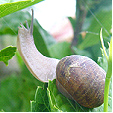
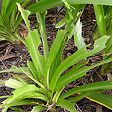
Appearance and Distribution of the Pest
Slugs and snails occur world-wide. Slugs tend to be more prevalent in heavier soil types.
Life Cycle
These insects have a Hemimetabolous life cycle, ie. When the immature nymphs resemble the adults.
Snail eggs are laid in moist soil, 20-40mm deep; eggs are white, spherical and appear in clusters of 30-100. Under favourable conditions, eggs hatch in 2-3 weeks. Newly emerged snails resemble tiny adults. When the weather is cold and dry, snails seal themselves into their shells where they survive, dormant, for 1-3 years.
Period of Activity
More active during the warmer months, although some species may remain active throughout the year.
Damage Caused
Native Australian slugs and snails are not commercial pests. Introduced species chew holes in foliage or skeletonise leaves; some plants may be completely defoliated plants; tubers and seedlings may be completely eaten. Slugs and snails feed mainly at night, especially after rain or watering; they shelter in cool, moist locations during the day. When the weather is dry, snails seal themselves into their shells with a mucous membrane, where they survive, dormant, for 1-3 years. Some species may consume up to one third of their body weight each day.
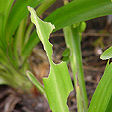
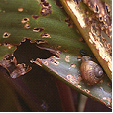
Susceptible Plants
A wide range of leafy plants, including ground crops, potatoes, tubers, leafy vegetables and seedlings.
Fern species are attacked causing serious damage. New fronds are repetitively eaten causing the plant to become stunted. Attacks are normally more severe during wet periods during which time control measures should be taken.
Morinda citrifolia is attacked by the Giant African Snail (Achatina fulica) which defoliates trees.
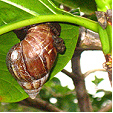

Cultural Control
Remove possible hiding places and avoid overhead watering to reduce humidity. Cultivate soil regularly; in commercial situations, allow the soil to remain fallow for one season to reduce numbers. Domestic infestations may be removed by hand. Traps may be created by inverting small pots near where snails and slugs are feeding; they will gather in these shelters during the day, and may be collected and destroyed. The popular Australian "beer trap" consists of a vertically-sided container, sunk into the ground and filled with beer, which intoxicates and drowns the snails.
Biological Control
Natural predators such as birds, frogs, and lizards reduce numbers, but do not provide effective control. Orchardists have used running ducks to control snails with some success.
Chemical Control
Commercial baits - molluscicides - made from methiocarb or metaldehyde are effective when used in combination with sanitation. Their effectiveness varies according to soil and weather conditions; it is generally recommended to avoid watering after application.
Note
Always read the label for registration details and direction of use prior to application of any chemicals.
PEST
NAME
Cutworms
Agrotis species
ORDER
Lepidoptera
FAMILY
Noctuidae
Description of the Pest
Cut worm larvae live in the soil, congregating in weedy areas; they chew off young seedlings at the base. They are smooth, thick fleshy grubs that vary in colour, from pinkish brown to olive green, or almost black. They grow up to 40mm long and 5mm thick. Larvae curl up when disturbed, pretending to be dead. Larvae burrow down into the soil to a depth of about 50mm to pupate. Adults are dark brown, hairy moths, with a wingspan of about 60mm.
These insects have a Holometabolous life cycle, ie. When metamorphosis is observed during the pupal stage.
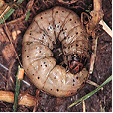
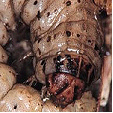
Appearance of the Pest
Adult moths are strong fliers capable of flying many kilometres laying eggs over a wide area. The eggs may remain dormant for several weeks until it rains or emerge within a few days under the right weather conditions.
Three similar species are commonly found in Australia:
· Agrotis ifusa (Bogong moth) is up to 50mm across and has three spots on its forewing.
· Agrotis munda (pink cut worm); and
· Agrotis ipsilon (black cut worm).
 Agrotis munda
Agrotis munda
Period of Activity
Different species are active throughout the year, their prevalence being determined by rainfall and temperature. They are normally most active at night. Larvae will appear in greatest numbers when favourable environmental conditions produce lush growth.
Susceptible Plants
Cutworms prefer soft, succulent seedlings or fleshy annuals, perennials and a variety for ferns or orchids. They feed at night and remain in the soil during the day. They are most commonly found in soil that is infested with weeds or soil that is poorly drained and moist. Well-drained soils harbour less lava.
Senecio and Dianthus species are attacked by the Cutworm (Peridroma margaritosa) which eats seedlings, leaves and flower buds. Under glasshouse conditions all stages of the lifecycle are present.
Turf Grasses are attacked by several Agrotis species causing damage during different seasons according to there individual life cycle. All feed at night on the leaves when young and mature larvae shear plants stems at ground level.
Damage Caused
Young larvae feed on the lower epidermis of leaves. Adults attack stems and seedlings at the base, eating the soft new growth, on one side, or completely through. The damaged plant normally topples over (hence the common name). Mature plants may wilt or the foliage becomes yellowish as a result of the damage, but normally recovers.
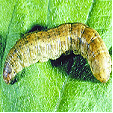
Cultural Control
Weed removal and cultivation to improve the drainage of the soil will provide some reduction in of numbers. Seedlings may be protected by a physical barrier, (eg plastic tube pushed into the soil around the seedling). Heavily infected soil can be laid fallow with for several weeks to disrupt the life cycle or the soil can be covered in black or clear plastic until weeds and lava are dead.
A molasses based bait that has hardwood sawdust and bran mixed with water creates a stick mass that the lava is attracted to but cannot escape. At sunrise they die from dehydration.
Biological Control
Natural predators such as birds, ground beetles and certain bugs help keep numbers down. Wasps and certain species of flies also attack the lava.
Encouraging earthworms by mulching and increasing the humus level is an excellent way to rid the soil of lava.
Chemical Control
Chemical treatment (Carbaryl) may be effective if sprayed in the evening, when the caterpillars emerge to feed.
Note
Always read the label for registration details and direction of use prior to application of any chemicals.
DISEASE
NAME
Leaf Scorch
Stagonospora curtisii
Description
This is a casual fungal problem that infects the leaves.
Symptoms
The leaf tips are reddish brown soon after emerging, with small raised or lacerated spots that form longitudinal lines. These spots may also appear on the bulb scales and the flower, turning yellow-brown with a scorched appearance.
The infected areas become thin and papery while the lower leaf forms oval brown spots. As the spots enlarge the enclosed tissue turns white and dies. The leaf generally has a pale green washed out appearance and a heavy infection causes the leaf to bend and die.
 Slimy base
Slimy base  Clivia miniata
Clivia miniata
Source and Dispersal
The fungus is found in the bud scales which are normally at ground level. The young leaves are infected as they grow past the scales. The spores are dispersed by wind or by the introduction of infested bulbs.
 Hemerocallis species
Hemerocallis species  White mycelium
White mycelium
Favoured Conditions
It prefers warm wet conditions that normally occur during spring as the leaves emerge.
Affected Plants
This fungus affects many bulbous plants including Daffodils, Jonquils, Belladonna lilies, Crinums, African lilies, Hippeastrums, Kaffir lilies.
Hemerocallis and Clivia species may be infected Leaf Scorch causing the tips of the leaves to brown off and die.

 Clivia miniata
Clivia miniata
Non-chemical Control
Infected leaves should be cut off and disposed of by burning. Heavily infested bulbs should be dispensed with.
Chemical Control
Preventative spraying of copper oxychloride (fungicide) should be carried out as the leaves emerge.
DISEASE
NAME
Virus (Generally)
Various Virus Species
Viruses can infect any plant and there are hundreds of types, but unlike fungi and bacteria viruses can only reproduce inside a living cell. Viruses are small requiring a magnification of x 10,000 to be seen and infection can be transmitted from one plant to another causing a variety of symptoms. Infected cells normal function, in the plant is diverted to aid the virus to reproduce by supplying nutrients and energy. The virus can spread from cell to cell or travel through the vascular system in the plant and may only infect a specific part of the plant, normally the new growth or the whole plant.
Lethal Yellowing
This fatal disease is not a virus, but of uncertain origin that is associated with mycroplasmas or mycroplasma-like-organism and infects palms, particularly Cocos nucifera (Coconut Palm).
The symptoms include premature dropping of the fruit at all stages (shelling) and these have brown-black water soaked areas under the calyx. The second symptom is the blacking of the new inflorescence as it is exposed from the spathe. Male flowers are also blackish and fruit will not set.
The third stage of this infection causes the lower fronds to turn yellow, eventually engulfing the entire crown. The fronds turn brown and easily fall from the plant and the infection kills the entire plant within 3 to 6 months with the crown falling away leaving a bare trunk.
Some palm species only exhibit the third stage making it difficult to diagnose, but generally a solitary frond will turn yellow, known as 'Flagging' and indicates Lethal Yellowing.
It is known to be transmitted by a plant-hopper (Myndus crudus) and currently there is no practical control.
Mosaic Virus generally is a viral problem that involves several viruses altering the production of chlorophyll in the leaf. It may only be seen on certain parts but the whole plant will be infected.
Symptoms

Mosaic Virus on Roses form variable yellow pattens on some of the leaves that are fine lined, imitating the veins with blotches or larger marks forming streaks.
Mosaic Virus on Cabbage, cauliflower and broccoli form yellow rings on immature leaves that turn shades of green as the leaf matures and eventually turning purplish-black in cooler weather.
The virus (Marmor iridis) infects Iris and Watsonia species leaves develop pale green streaks on the leaf that become larger then turn brown eventually killing the leaf. The virus prevails in the rhizome from season to season and is a serious problem reducing and damaging flower production.
Phloem Necrosis (Morsus ulmi) is a serious disease of Ulmus species. The initial symptoms occur at the apex and on branch tips where the leaves droop as the petiole is affected. The leaf margins curve upwards and the leaf turns greyish then yellow and then falls, overall giving the tree a sparse appearance. As the virus matures it infects the phloem tubes turning them yellowish, and then brown eventually killing the cells. The roots die and the entire tree may gradually decline over eighteen months, or in acute cases a tree may die within three weeks.
Pumpkin and zucchini are attacked from a virus commonly known as 'Watermelon virus' which affects the leaves by making them mottled in light or dark green and may become distorted. This inhibits the size of the plant and the fruit may have sunken areas with concentric rings.
Tobacco is infected by a Tobacco Mosaic virus (Marmor tabaci) and a Ring virus (Annulus tabaci).
Tulip Breaking (Marmor mite) causes yellowish-white, light coloured striping or spotting of the flower and reduces the size and vigour of the plant in Tulipa species. It may also affect the growth of the bulb and offsets and is more prevalent in double-flowering varieties.
Yellows (Chlorogenus callistephi) is a viral disease that causes leaves to turn yellow and produces shoots that are simular to Witches Broom or flowers that have poor colouring. The infection will not kill the plant as it overwinters and spreads infection from the living host via the Leaf Hopper (Macrosteles fascifrons). It is not found in the soil or in seeds but is a major problem for Aster species.
Source and Dispersal
The source and the dispersal vary depending on the particular Virus that is involved. In roses the virus overwinters on fallen leaves or pruned pieces of plant material. It is also found on infected plants and is spread by infected propagation material. Aphids transmit this Mosaic Virus.
Infected cabbage, cauliflower and broccoli are an excellent source for aphids, such as the green peach aphid to disperse.
Iris rhizomes are the source and the virus (Marmor iridis) is spread by aphids and infected rhizomes during propagation.
Phloem Necrosis is thought to be transmitted by the Elm Leafhopper (Scaphoideus luteolus) or by infected rootstocks.
Pumpkin and zucchini are infected from surrounding weeds or other infected plants by several aphids including the cotton aphid and the green peach aphid.
Generally plants are infected by viruses by, rubbing against each other or through grafting, budding and other vegetative means such as wounds. Insects also transmit viruses by sucking sap or transferring infected pollen.
Favoured Conditions
Viruses prefer warm humid climate.
Affected Plants
A wide range of plants are affected from a range of Mosaic viruses causing simular symptoms. These include roses, cabbage, cauliflower, broccoli, iris, pumpkin, zucchini, turnips, capsicum, swedes, stocks, alyssum and wallflowers. Shrubs and trees such as Ulmus species are also infected.
Abutilon species may be infected by the Mosaic Virus ((Marmor abutilon) which causes variegation of the leaves.
Aquilegi, Berberis Passiflora and Tulipa species are infected by the Cucumber Mosaic Virus (Marmor cucumeris). This causes yellow streaking or mottling in the leaves and dark coloured patches to appear on the flowers. It also stunts the plant and prevents flowering.
Lilium and Tulipa species are infected by the Mosaic virus (Marmor mite) causing yellow mottling on the leaves.
Palms are infected by Lethal Yellowing include, Pritchardia martii and Phoenix canariensis.
Non-chemical Control
With roses if the problem is minor it may be ignored as the flower production will be normal. Heavily affected plants should be disposed of.
Other plants that are infected should be removed and destroyed. The spread may be arrested by the eradication of aphids by applying soapy water.
Chemical Control
Once the virus is seen it is too late to spray. Preventative spraying to control aphids should be carried out in spring using Dimethoate. There is no satisfactory chemical control for viruses.
DISEASE
NAME
Grey Mould
Botrytis cinerea, B. elliptica
Description
Grey Mold, Shoot Blight, Petal Blight is a fungus problem that generally forms water-soaked spots that rot and produces greyish sclerotia (fungal resting bodies) on the surface. They can be found throughout the year on dead tissue and on live material during under ideal climatic conditions. Damaged areas such as a tear in a leaf or an opening made by an insect are more likely to be infected.
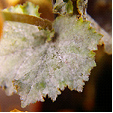 Grey Mold on Begonia species
Grey Mold on Begonia species
Image by B. Sonsie
Symptoms
The fungus attacks stems, leaves, flowers and fruit. In roses the fungus is primarily attacks the flowers producing pink rings on the petals and buds that become brown and rotten. This may extend down the peduncle to the stems causing dieback.
In other plants oval yellowish to brown spots appear, then the centre turns greyish and dries out and in humid weather the spots spread, joining up and infecting the entire leaf. This infection may also occur on the stems, and flowers may form abnormally or brown off and die.
When lettuce is infected it starts at the base causing a soft brown rot that may extend up the stem killing the plant, and pears flowers become infected then spreading to the fruit. This develops a sunken brown area that is soft and eventually is covered in grey powdery spores.
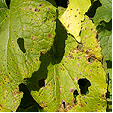
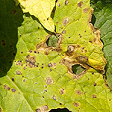 Botrytis Blight on Senecio cruentus
Botrytis Blight on Senecio cruentus
Botrytis Blight (Botrytis tulipae) infects leaves, flowers and stems with flecks of brown spots that merge to form light grey rotted areas that have brownish margin that may destroy stems. Affected areas are covered in a grey mould during humid conditions. The spores overwinter in dark brown sclerotia, which are found on the outer scales of the bulb or at the base of the stem in Tulipa species.
Grey Bulb Rot (Rhizoctonia tuliparum), which infects the bulbs of Tulipa species, attacking the base of the leaves and rotting the bulb. When bulbs emerge during spring in infected soil's they soon die off. The greyish mold tends to be dry.
Source and Dispersal
The sclerotia (fungal resting bodies) are found on dead plant material or in the soil and remain viable for many years. The spores are dispersed by wind or splashing water.
Favoured Conditions
It prefers cool moist climate with morning dew.
Affected Plants
Grey Mold attacks a wide range of plants including roses, fruit trees, pelargonium, ferns, grapes and cyclamens. Heliotropium , Amaryllis, Lilium and Hippeastrum species are also infected.
Agave species are infected by two fungal Leaf Blights (Botrytis cinerea) and (Stagonospora gigantea) that severely damage the leaves particular during wet periods or from excessive watering.
Cactus species are infected by soft rot or Grey Mould (Botrytis cinerea). Stems and pads turn are greyish with the upper surface, rotting then collapsing. The dieing tissue becomes slimy and is covered with grey mould that develops black sclerotia, which propagates the disease. It is more prevalent under warm humid conditions and control methods include removing infected parts and destroying them. In glasshouse situations ventilation should be improved and watering should be restricted to create a drier atmosphere.
Cereus species and other cacti are infected by Grey Mold causing the segments to become discoloured and as the rot progresses it tissue becomes slimy and collapses. Black sclerotia forms on the affected areas that are covered in grey mold during humid conditions.
Cuphea species are infected by this blight.
Orchids such as Cattleya, Cymbidium, Cypripedium, Dendrobium, Epidendrum, Oncidium, Paphiopedilum, Phalaenopsis and Zygopetalum species are infected by Grey Mold or Petal Spot (Botrytis cinerea). Petal and flower stalks form small brown spots.
Paeonia species are infected by Botrytis Blight (Botrytis paeoniae) causing the leaves and flowers to form a grey mold then suddenly collapse and die.
Pseudotsuga menziesii Douglas Fir is infected by Leaf and Twig Blight (Botrytis cinerea). This is a serious problem in wet conditions and is difficult to control.
Ribes species are attacked by Cain Blight (Botryosphaeria dothidea). The infection causes the cains to become blighted and wilt. To control remove damaged wood and destroy.
Non-chemical Control
Remove and destroy infected plants or fallen leaves. When planting, space as to allow good air movement to reduce humidity. Bulbs that are infected should be discarded and take care that bulb scales are removed from the soil to prevent further infection. Cactus and succulents that are infected should have the damaged areas cut out, or discard the entire plant. Under glasshouse conditions improve the ventilation and reduce watering to create a drier atmosphere.
Chemical Control
Under humid conditions spray regularly using a suitable fungicide such as thiram, mancozeb, dichloran and chlorothalonil.
Note
Always read the label for registration details and direction of use prior to application of any chemicals.
DISEASE
NAME
Armillaria Root Rot, Honey Fungi
Armillaria luteobubalina
Description
This naturally occurring fungus grows between the bark and wood of trees producing distinctive cream sheets of hyphae. The toadstool-like fruiting bodies are yellowish brown and appear from the soil or sprout out of the base of the host plant.
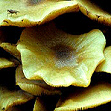
Image by Dr Brett Summerell
Symptoms
This is a vigorous fungus that attacks the roots of trees and is not normally noticed until dieback starts to occur. Affected plants generally appear declined, with some dieback and by this stage; the disease may be well established. Leaves can turn yellow, shrivel and fall from the plant and the branches die back. Citrus trees may produce a heavy crop of fruit just before death. Splits often occur on the trunk of affected trees and the bark may lift revealing white sheets of mycelium or hyphae under the bark. These hyphae will have a distinctive "mushroom" smell. Affected roots become spongy, powdery or jelly-like and when dissected reveal similar white sheaths under the bark. Infected plants may survive for many years before final death of the tree.
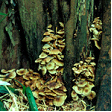
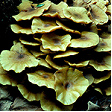
Image by Dr Brett Summerell
Source and Dispersal
This fungus is a native species that is naturally found in Eucalyptus forests and woodlands throughout eastern Australia and south-western Australia. It is commonly found on old tree trunks and decaying wood where honey coloured toadstools appear from the base of the host or surrounding soil in May-June. The toadstools produce white spores that are dispersed by wind, but generally the fungus spreads underground through contact between infected and uninfected roots. The fungus can grow about 1-1.5 metres per year along a root. This species, unlike those in the northern hemisphere does not produce rhizomorphs, thick strands that are flat resembling shoe-strings.
 Mycelium on wood
Mycelium on wood 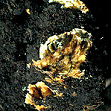
Image by Dr Brett Summerell
The fungus is not spread by contaminated soil as it only grows in root material. Spread to new sites is either through spore movement (very rare), movement of infected plants or through movement of contaminated wood chip used for mulch. Dead or dying trees should be inspected for the presence of this pathogen prior to use as mulch.
This fungus can survive for many years in infested root and stem material depending on the size of the material and speed of decomposition of the wood.
Favoured Conditions
This fungus prefers sandy soil types and is more frequently found in more freely drained soils. Moisture is required for growth of the fungus along the root system. Generally the damage caused to plants is greater on plants that are already under stress or weakened. The retention of infested root systems and stumps in the soil has contributed to an increase in the occurrence of this disease.
Affected Plants
The host range for this fungus is extremely wide and includes many ornamentals and Australian native plants. Fruit trees and perennials are also commonly attacked. The most susceptible species include oaks, camellias, azaleas, roses and eucalypts.
Amaryllis, Narcissus and Hippeastrum species are also infected.
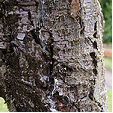 Cedrus species trunk
Cedrus species trunk 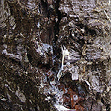
Image by Dr Brett Summerell
Cedrus species are also affected by Armillaria root rot causing the roots to rot and the trunk to swell and spilt open. There is no control for these infections.
Non-chemical Control
Control of this disease is totally dependent on removal of the inoculum of the fungus from the soil. To be effective this will require removal of the infested roots and stem, a process that may be difficult in garden beds. Infected plants should be removed and disposed of, but it is not necessary to remove the surrounding soil as the fungus only occurs in the plant. When clearing affected land for cultivation, remove all stumps and roots and allow 2 to 3 years prior to replanting.
Trees that are in the early stages of attack may be saved by removal of the affected roots and leaving remaining roots exposed for several years. Top soil around the trunk should also be removed for a distance of up to 1m and affected trees should be fertilised and watered to encourage vigour.
Chemical Control
There is no practical or effective chemical control. Fumigation has been carried out to eradicate the fungus but success is dependent on the removal of large sources of inoculum. However many of the chemicals used for this purpose are highly toxic and have restricted usage now.
Note
Always read the label for registration details and direction of use prior to application of any chemicals.
Amendments by
Dr Brett Summerell
Director Science and Public Programs
Royal Botanic Gardens Trust, Sydney
Average Lowest Temperature : -3º C 27º F
USDA : 10, 11
This USDA (United States Department of Agriculture) hardiness zone chart can be used to indicate a plant’s ability to withstand average minimum temperatures. However, other factors such as soil type, pH, and moisture, drainage, humidity and exposure to sun and wind will also have a direct effect on your plant’s survival. Use this chart only as a guide, always keep the other factors in mind when deciding where, when and what to plant.
A plant's individual USDA zone can be found in the Plant Overview.
Climate Description
Warm Temperate
This zone has the majority of rain during winter in the west and summer in the east with high humidity. Summer temperatures may peak at 40ºC (104ºF).
Frost and drought mainly occur inland and coastal wind is normally accompanied with rain.
Plant growth
Wide range of native and exotic plants grow well.
| Dictionary | Growth Habit |
| Leaf Type | Botanic Flower Description |
| Leaf Shape | Flower Inflorescence |
| Leaf Arrangement | Fruit Type |
| Leaf Margin | Bark Type |
| Leaf Apex And Bases | Flower Description |